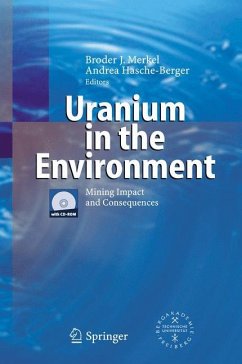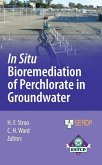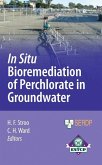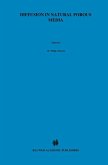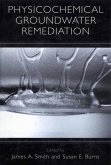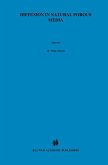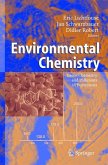This book presents the results from the Uranium Mining and Hydrogeology Congress held in September 2005, in Freiberg, Germany. It addresses scientists and engineers involved in the areas of uranium mining and milling sites, clean-up measures, emissions of nuclear power plants and radioactive waste disposal, as well as political decision-makers.
The topics covered are: impact on groundwater from radionuclide emission, analytical specification techniques, chemical toxicity, radioisotope plant uptake, microbiology, geochemical and reactive transport, case studies on active and abandoned uranium mines and milling sites, long-term storage of radioactive waste, passive in situ treatment techniques and risk assessment studies.
The accompanying CD-ROM includes all papers in colour.
Uranium is an element to be found ubiquitous in rock, soil, and water. Uranium concentrations in natural ground water can be more than several hundreds µg/l without impact from mining, nuclear industry, and fertilizers. Considering the WHO recommendation for drinking water of 15 µg/l (has been as low as 2 µg/l before) due to the chemical toxicity of uranium the element uranium has become an important issue in environmental research. Besides natural enrichment of uranium in aquifers uranium mining and milling activities, further uranium processing to nuclear fuel, emissions form burning coal and oil, and the application of uranium containing phosphate fertilizers may enrich the natural uranium concentrations in soil and water by far. In October 1995 the first international conference on Uranium Mining and Hydrogeology (UMH I) was held in Freiberg being organized by the Department of Geology at the Technical University Bergakademie Freiberg by the support of the Saxon State Ministry of Geology and Environment. Due to the large scientific interest in the topic of uranium a second conference (UMH II) took place in Freiberg in September 1998. Furthermore, in September 2002 scientists working on the topic of uranium mining and hydrogeology attended the third conference (UMH III) which was jointly held together with the International Mine Water - sociation (IMWA) Symposium 2002. The reviewed papers and posters of the 2002 conference have been published by Springer entitled Uranium in the aquatic en- ronment (edited by Merkel, Planer-Friedrich and Wolkersdorfer).
The topics covered are: impact on groundwater from radionuclide emission, analytical specification techniques, chemical toxicity, radioisotope plant uptake, microbiology, geochemical and reactive transport, case studies on active and abandoned uranium mines and milling sites, long-term storage of radioactive waste, passive in situ treatment techniques and risk assessment studies.
The accompanying CD-ROM includes all papers in colour.
Uranium is an element to be found ubiquitous in rock, soil, and water. Uranium concentrations in natural ground water can be more than several hundreds µg/l without impact from mining, nuclear industry, and fertilizers. Considering the WHO recommendation for drinking water of 15 µg/l (has been as low as 2 µg/l before) due to the chemical toxicity of uranium the element uranium has become an important issue in environmental research. Besides natural enrichment of uranium in aquifers uranium mining and milling activities, further uranium processing to nuclear fuel, emissions form burning coal and oil, and the application of uranium containing phosphate fertilizers may enrich the natural uranium concentrations in soil and water by far. In October 1995 the first international conference on Uranium Mining and Hydrogeology (UMH I) was held in Freiberg being organized by the Department of Geology at the Technical University Bergakademie Freiberg by the support of the Saxon State Ministry of Geology and Environment. Due to the large scientific interest in the topic of uranium a second conference (UMH II) took place in Freiberg in September 1998. Furthermore, in September 2002 scientists working on the topic of uranium mining and hydrogeology attended the third conference (UMH III) which was jointly held together with the International Mine Water - sociation (IMWA) Symposium 2002. The reviewed papers and posters of the 2002 conference have been published by Springer entitled Uranium in the aquatic en- ronment (edited by Merkel, Planer-Friedrich and Wolkersdorfer).
"Andrea Hasche-Berger and Broder J. Merkel did a magnificent job in gathering together 92 contributions within a short time interval for rapid publication. ... the book's figures appear in a good black-and-white quality, and additionally all articles are published in colour on the accompanying CD-ROM, enabling the reader to really use all the figures. ... The book is a good source that gives an overview on the international work in the field of uranium ... ." -- Andreas Winkler, Environmental Geology, Vol. 51, 2006
From the reviews:
"Andrea Hasche-Berger and Broder J. Merkel did a magnificent job in gathering together 92 contributions within a short time interval for rapid publication. ... the book's figures appear in a good black-and-white quality, and additionally all articles are published in colour on the accompanying CD-ROM, enabling the reader to really use all the figures. ... The book is a good source that gives an overview on the international work in the field of uranium ... ." (Andreas Winkler, Environmental Geology, Vol. 51, 2006)
"Andrea Hasche-Berger and Broder J. Merkel did a magnificent job in gathering together 92 contributions within a short time interval for rapid publication. ... the book's figures appear in a good black-and-white quality, and additionally all articles are published in colour on the accompanying CD-ROM, enabling the reader to really use all the figures. ... The book is a good source that gives an overview on the international work in the field of uranium ... ." (Andreas Winkler, Environmental Geology, Vol. 51, 2006)

